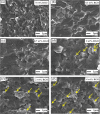Grain Boundary Interfaces Controlled by Reduced Graphene Oxide in Nonstoichiometric SrTiO3-δ Thermoelectrics
- PMID: 31197239
- PMCID: PMC6565681
- DOI: 10.1038/s41598-019-45162-7
Grain Boundary Interfaces Controlled by Reduced Graphene Oxide in Nonstoichiometric SrTiO3-δ Thermoelectrics
Abstract
Point defect or doping in Strontium titanium oxide (STO) largely determines the thermoelectric (TE) properties. So far, insufficient knowledge exists on the impact of double Schottky barrier on the TE performance. Herein, we report a drastic effect of double Schottky barrier on the TE performance in undoped STO. It demonstrates that incorporation of Reduced Graphene Oxide (RGO) into undoped STO weakens the double Schottky barrier and thereby results in a simultaneous increase in both carrier concentration and mobility of undoped STO. The enhanced mobility exhibits single crystal-like behavior. This increase in the carrier concentration and mobility boosts the electrical conductivity and power factor of undoped STO, which is attributed to the reduction of the double Schottky barrier height and/or the band alignment of STO and RGO that allow the charge transfer through the interface at grain boundaries. Furthermore, this STO/RGO interface also enhances the phonon scattering, which results in low thermal conductivity. This strategy significantly increases the ratio of σ/κ, resulting in an enhancement in ZT as compared with pure undoped STO. This study opens a new window to optimize the TE properties of many candidate materials.
Conflict of interest statement
The authors declare no competing interests.
Figures










Similar articles
-
Selective Enhancement in Phonon Scattering Leads to a High Thermoelectric Figure-of-Merit in Graphene Oxide-Encapsulated ZnO Nanocomposites.ACS Appl Mater Interfaces. 2021 May 26;13(20):23771-23786. doi: 10.1021/acsami.1c04125. Epub 2021 May 17. ACS Appl Mater Interfaces. 2021. PMID: 34000188
-
Improved Thermoelectric Properties of SrTiO3 via (La, Dy and N) Co-Doping: DFT Approach.Molecules. 2022 Nov 16;27(22):7923. doi: 10.3390/molecules27227923. Molecules. 2022. PMID: 36432025 Free PMC article.
-
Electrochemical Studies of SrTiO3/Reduced Graphene Oxide Composite for High-Power Energy Storage and Oxygen Evolution Reaction Applications.Chemphyschem. 2025 Jun 2;26(11):e202500038. doi: 10.1002/cphc.202500038. Epub 2025 Apr 6. Chemphyschem. 2025. PMID: 40105128
-
Modification of Bulk Heterojunction and Cl Doping for High-Performance Thermoelectric SnSe2/SnSe Nanocomposites.ACS Appl Mater Interfaces. 2018 May 9;10(18):15793-15802. doi: 10.1021/acsami.8b00524. Epub 2018 Apr 30. ACS Appl Mater Interfaces. 2018. PMID: 29671310
-
Compromise and Synergy in High-Efficiency Thermoelectric Materials.Adv Mater. 2017 Apr;29(14). doi: 10.1002/adma.201605884. Epub 2017 Mar 6. Adv Mater. 2017. PMID: 28262991 Review.
Cited by
-
Controlling the Thermoelectric Behavior of La-Doped SrTiO3 through Processing and Addition of Graphene Oxide.ACS Appl Mater Interfaces. 2022 Dec 7;14(48):53711-53723. doi: 10.1021/acsami.2c14408. Epub 2022 Nov 22. ACS Appl Mater Interfaces. 2022. PMID: 36413504 Free PMC article.
-
Improved Electromagnetic Interference Shielding Efficiency of PVDF/rGO/AgNW Composites via Low-Pressure Compression Molding and AgNW-Backfilling Strategy.Nanomaterials (Basel). 2024 Sep 21;14(18):1531. doi: 10.3390/nano14181531. Nanomaterials (Basel). 2024. PMID: 39330687 Free PMC article.
-
Modulation of Charge Transport at Grain Boundaries in SrTiO3: Toward a High Thermoelectric Power Factor at Room Temperature.ACS Appl Mater Interfaces. 2021 Mar 17;13(10):11879-11890. doi: 10.1021/acsami.0c21699. Epub 2021 Mar 4. ACS Appl Mater Interfaces. 2021. PMID: 33660994 Free PMC article.
-
A Review of Key Properties of Thermoelectric Composites of Polymers and Inorganic Materials.Materials (Basel). 2022 Dec 5;15(23):8672. doi: 10.3390/ma15238672. Materials (Basel). 2022. PMID: 36500167 Free PMC article. Review.
-
Electronic structure and thermal conductance of the MASnI3/Bi2Te3 interface: a first-principles study.Sci Rep. 2022 Jan 7;12(1):217. doi: 10.1038/s41598-021-04234-3. Sci Rep. 2022. PMID: 34997126 Free PMC article.
References
-
- Zhao L-D, Dravid VP, Kanatzidis MG. The panoscopic approach to high performance thermoelectrics. Energy Environ. Sci. 2014;7:251–268. doi: 10.1039/C3EE43099E. - DOI
-
- Tritt TM, Subramanian M. Thermoelectric materials, phenomena, and applications: a bird’s eye view. MRS bull. 2006;31:188–198. doi: 10.1557/mrs2006.44. - DOI
-
- Ohta H. Thermoelectrics based on strontium titanate. Mater. Today. 2007;10:44–49. doi: 10.1016/S1369-7021(07)70244-4. - DOI
-
- Lee S, Wilke RHT, Trolier-McKinstry S, Zhang S, Randall CA. SrxBa1-xNb2O6-δ Ferroelectric-thermoelectrics: Crystal anisotropy, conduction mechanism, and power factor. Appl. Phys. Lett. 2010;96:031910. doi: 10.1063/1.3291563. - DOI
LinkOut - more resources
Full Text Sources

